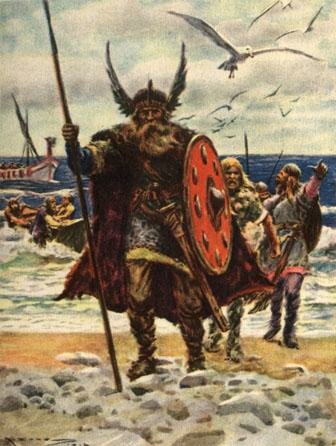Top 10 Oldest Recorded Histories
Suggested by SMSWhile there are many interpretations of “Recorded History” that can be considered in addressing this list, some are bound to prejudices and other limitations to our thinking that cannot be accepted in intelligent conversation. For this reason the list has tried to take into account the Oldest Recorded Histories of as many continents as possible and the definition of “Recorded” has been applied generously to include more than simply the written word.
However, there is still the capacity for some histories to overlap or coincide and this has made distinction difficult at times. For this reason some of the histories discussed here have been selected with a hope of balancing “Oldest” with “Important”.
10. Mycenaean Greece

The definition of “recorded” history leaves some room for interpretation in that the nature of the recording can come in many forms. In the case of the Mycenaean civilization there must be the reluctant acceptance that much of the earliest history is entwined in the legends and mythology of Homer. However, the very presence of Homer means that, whether we accept the story fully or not, there was a Mycenaean people to whom the stories were told.
There is evidence of the Mycenaean people are far back as 2800 BCE. They are believed to have been Indo-Europeans who mingled with the native Greeks and seamlessly became part of the tribes. But by 1600 BCE, the Mycenaean civilization was flourishing and the wealth of the Mycenaeans was such that Shaft Graves around this time were outrageously adorned with amazing material wealth. The whole art of burial was impressive with other high ranking and noble people being buried in a sitting position inside large beehive-like structures.
Among the defining moments of Mycenaean history was the Trojan War. This was recorded in oral tradition for four centuries before Homer wrote the Iliad and committed the tale to a form that limited the continuing desire for demigod status among the Mycenaeans’ ancestors.
As citizens of city-states, the Mycenaeans were never a single nation in the literal sense. However, in the event of a potential threat, the cities would band together under one leader, knowing that there was greater strength in working together.
Some historians explain the collapse of the Mycenaean civilization as an unfortunate by-product of the close of the Bronze-Age. Others recognize the invasion of the Dorians as a major shift in the balance of the region and the subsequent overthrow of the Mycenaeans as an almost inevitable consequence. But, perhaps in keeping with the blending of myths, legends and exciting facts that make such wonderful accounts of their history there are acknowledged theories that insist on the decline of the Mycenaeans being due to a series of natural disasters and climate change.
9. Xia Dynasty

While civilizations were beginning to blossom around the Euphrates and Tigris, there were other ancient civilizations that were growing on other rivers. In China, the Yellow River, or Huang He, was the life source of Xia Dynasty, the first recorded civilization in China.
There are a number of chronologies used in dating the history of China, but the traditional chronology claims that the Xia Dynasty ruled between 2205 and1766 BCE. By comparison with the Akkadians and Sumerians, the ancient Xia seems to be almost youthful, but in the context of a region that would grow to accommodate over a billion people and one sixth of the world’s population, the oldest recorded civilization must be acknowledged.
The origins of the Xia are recognized as a gathering of tribes during the period of the Five Emperors. The earliest recorded member of the clan was Gun, a man of some ingenuity and diplomacy, who was set the task of stopping the flooding of the Yellow River. He brought together members of many tribes to build a levy that would take the flooding river. But short term success was thwarted as the floods continued to grow in ferocity and, after nine years of toil, Gun’s efforts were declared a failure and, as one would expect in that time and place, he was executed.
In what might appear almost spiteful irony, his position was then passed on to his son, Yu, who probably hoped to restore the family name by succeeding where his father hadn’t. He also was able to unite the tribes, but rather than building a levy, he put the people to work digging canals that would drain the excess water to the sea. The project lasted a further thirteen years and Yu’s perseverance and brilliance were rewarded with his being proclaimed the next ruler by the dying Shun.
The fertile soil and consistent water supply allowed the Xia Dynasty to survive for centuries. But sadly, the last king Jie was corrupt and, with waning support he was overthrown by Tang, the first ruler of the Shang Dynasty.
8. Hittite

As a civilization, the Hittites often appear on the fringes of other people’s stories. They settled into a kingdom in the eighteenth century BCE, but did really make a name for themselves for another four hundred years. By then they had made inroads to Asia-Minor, modern-day Turkey, Syria and upper Mesopotamia. They would continue to be a force in the region for another three centuries.
The Hittites established themselves through their expertise with chariots in battle and expanded gradually through Anatolia. But while they were growing their kingdom, they also gained notoriety in the Bible as they were mentioned more than once as fighting with the Israelites and their presence living within them was commonplace.
When Mursilis I set out on raids down to the Euphrates around 1590 BCE, the Amorite Empire was all but lost. Mursilis I was an effective leader and his successes were achieved with fortitude and guile, but the common opinion is that the Amorites were already on the slide. The added pressure of the Hittites was simply enough to remove any final resistance and the Amorites virtually imploded for them.
This seemed to be the way of many empires and so it was not overly ironic that the Hittites themselves fell victim to civil war and internal strife. The pressure added to the situation by the Sea People did as much to speed up the process at the Hittites had done for the Amorites. By 1160 BCE the Hittite Empire had collapsed and, although there were remnants still forming pockets of the old empire for another four centuries, the greater part of the Hittite territory was overrun by Phrygians.
7. Hebrews

While the Hebrew are often considered simply a Semite branch of Babylonia, by striking out and creating a civilization in their own right they stepped clear of any other culture’s banner. The popular record that was kept of the journey and their experiences also contributes to them being one of the most important of ancient civilizations.
Although establishing an exact date for the beginning Abraham’s migration with this people is difficult, there is reason to believe that it may have been linked to the period of Elamite invasion and conquest. The unsettledness of Babylon while under threat from the Elamites and the potential violence that could be brought against his own people could have provided adequate cause for Abraham to decide it was time to move.
This would have put his first step from “Ur of the Chaldees” at about 2285 BCE. Following the same timeline, the role of Joseph as a leader in Egypt would have occurred at approximately 1720 BCE and Moses would have led the exodus around 1300 BCE.
On the way to the Promised Land, Abraham would have taken his tribe to Haran, near the upper Euphrates, and eventually led them into Canaan, modern-day Palestine. This land would have appeared the one God had intended with fertile soil, a comfortable clime and few inhabitants.
There is evidence that it was here that Abraham decided enough was enough as the Elamites persisted in the horde-like behaviour. His meek band of nomads turned to become a ferocious army and inflicted enough damage on that led by Chedorlaomer that he freed prisoners, liberate goods and sent the Elamites on their way once and for all.
There were numerous other significant leaders and characters to the Hebrew story including Saul, David and Solomon and their history grew into the rich tales of the Old Testament of the Bible. But while it can certainly be regarded as an “ancient civilization”, it is imperative to recognise that it is one of the few to still be alive and functioning today. Different in many ways and more far-flung than most, there is still a strong sense of the ancient Hebrew in synagogues around the world.
6. Akkadian

Believed to have been located on the Euphrates between Sippar and Kish, the city of Akkad was the center of the Akkadian Empire. Established in 2350 BCE, this was a civilization that shared Mesopotamia with the Sumerians and developed a close relationship with them.
At the height of its political power, the Akkadian Empire was led by Sargon the Great and his descendants. Sargon, himself, reigned for an astounding fifty-six years in a time when living for that length of time was an exceptional feat. This meant that almost two generations of the Akkadian people would have been ruled by the same man.
The next four kings ruled for a total of eighty-eight years between them, so the five monarchs reigned for a total of 142 years and they ruled over a golden age for their people. So influential were the Akkadians that their language gradually displaced Sumerian and became the accepted tongue of the region. The arts reached new levels of appreciation and the Akkadians were respected as a major civilization of ancient times.
5. Minoan

The Minoan Civilization of Crete is estimated to have begun to take shape between 2700 BCE and 2500 BCE, but the presence of inhabitants on the island has been dated back as far as 7000 BCE. These discoveries indicate that there was a preceramic farming community on the island, but there is little claim to there being any functioning civilization at the time. Crete is a sizeable island to the south of Greece, located between the Aegean and the Mediterranean Seas.
The Minoan Empire is believed to have been at its most affluent and influential early in the second millennium BCE. There is evidence of the Minoan culture on the Greek mainland and it is believed that there was significant trade and exchange of ideas with Egypt through this time. Papyrus was a particularly sought after commodity and it has been suggested that Egyptian hieroglyphics were the basis for the Minoan pictograph system of writing.
As there has been no real success in translating Minoan writing there is much still to be learned about the civilization often described as the first advanced civilization in Europe. Even the cause of its rapid decline is a matter of conjecture.
However, a commonly held theory is that a volcanic eruption on the island of Thera, modern-day Santorini, which was only about a hundred kilometres from Crete had a devastating effect on the civilization. Projecting more than 60km3 (14.4miles3) of material into the air, the eruption buried the Minoan town of Akrotiri in a layer of pumice.
There are also suggestions that this was the origin of the legend of Atlantis as the island was almost completely lost beneath the ash and debris of the eruption and a great civilization was all but doomed in the its wake.
4. Indus Valley
Like most successful civilizations, the cities of Harappa and in Mohenjo-Daro were built on a river. As well as providing a reliable water source, the Indus River also supplied a rich and fertile flood plain that was the center of the civilization that began in the Indus Valley more than 4500years ago. Covering an area of almost 1.25 million kilometers (Approximately 308,881,453 acres; a little under twice the size of Texas), the region today includes Afghanistan, Pakistan and north-western India.
The two major cities of the Indus Valley were each home to about 35,000 people, but it wasn’t the size of the cities that reflected the sophistication of the civilization. The houses of the cities were built of brick and stone on roads that were remarkably straight. They also enjoyed drainage systems and water storage schemes that were the most efficient of any of the ancient counterparts. As mundane as they might appear to us today, these feats were the result of highly specialized engineering and building skills.
In other aspects of life the inhabitants of the Indus Valley were exceptionally talented. They had a system of weights and measures that made trade fair and reliable; children had toys and games that were beautifully crafted; jewelry was designed and fashioned to complement the beauty and possibly even match the lipstick of the ladies that wore it.
Records of the Indus Valley are not so much hard to come by, but they are hard to understand. Although there is a clear and deliberate form to the images and writing discovered from the ancient civilization, unlike others there is no way of interpreting the writing from the Indus Valley.
Despite the fact that we can’t necessarily follow the written word of the Indus Valley, given its age and the brilliance of its design and engineering, it remains one of the truly great ancient civilizations.
3. Druids

While some civilizations were recorded through cuneiform writing and others through hieroglyphics, the idea of a civilization being recorded in the works of others and in a mysterious arrangement of large rocks can’t be dismissed for want of translation. If this were the case, the only legitimate civilizations would be those that won the battles and wrote the history. Therefore it makes sense to include a civilization of peaceful mystics in this list.
The Druids were a culture that grew with the Celts. They had a pagan belief system and were central to the social and political structure of the Celts. It was only through the Druids that many of the scattered and diverse Celtic tribes could subscribe to some semblance of unity.
From the work of numerous Greek and Latin scholars, it is clear that the Druids were heavily involved throughout Britain, Ireland and Gaul. They played an important part in the resistance against the Romans and later against Christianity in Ireland, but their lack of success in both arenas could well explain the lack of more traditional records.
But, despite these relatively recent disappointments, one of the most remarkable and persistent pieces of evidence of their power among the ancient tribes of Britain still stands on the plains of Salisbury. The unified effort required to transport the materials and erect the structure that is Stonehenge is a magnificent indication of the high regard in which the Druids were held.
The Stonehenge that is seen today is the product of three separate stages of development, the first having been ditch and bank arrangement constructed around 3000 BC. The larger stones are believed to have been hauled to the site by a workforce of at least six hundred men per stone and were finally completed around 1500 BC.
For any religious or political group to have the pulling power to bring together the numbers required for this task and to be able to sustain their status for as long as the Druids, they must have developed a sophisticated and efficient civilization.
2. Egypt

The name Egypt often arouses images and tales of power, opulence and majesty. But to place the Egyptian people in the timeline of the oldest recorded histories, it is important to recognize that they took a few attempts to really spark their society into life.
The first settlers on the Nile made the river their home around 3500 BCE, but it would be another four hundred years before a true dynasty would be established that would unite the people of the upper and lower Nile into the civilization we know as Egypt. As for the iconic pyramids that are so often the wonders of an ancient world, these would not be built for almost another four hundred years again.
That is not to suggest that the Egyptians weren’t a fascinating people or that their achievements should be dismissed. The mathematics and engineering brilliance of a people that could construct with such precision these huge monuments must be applauded. Similarly the understanding of early science that allowed for the mummification of their pharaohs indicates a leap of technology that belied their time in history.
It would be a disservice to begin to discuss the many impressive and noble leaders of Egypt without the time to explore their lives fully. But, in terms of discussing leadership, it must be acknowledged that Egypt was a civilization that not only sustained its own story; it contributed to so many of the stories of the civilizations around it that its influence is still being felt today.
1. Sumerians

Evidence of the Sumerians culture and civilization has been found dating back to 4500 BCE. While there is debate over the connection between the Ubaidians and the Sumerians, the undoubted fact is that the Ubaidians drained marshlands, so that they could farm the fertile soil.
Although the Ubaidians were non-Semitic, there is plenty of material that suggests that the ancient names of the Old Testament were present or at least known to the people of the region. By the time the inhabitants were able to be identified categorically as Sumerians, their civilization was already well established. Occupying large tracts of Mesopotamia, Sumer developed in the area that is modern-day Iraq and city-states were established along both the Euphrates and Tigris Rivers.
The Sumerians’ contributions to history are astounding given how early in history they were making them. They devised a calendar made up of 12 months, each of thirty days in length, a total of 360 days. Many of the materials that they used in everyday life weren’t found naturally in the local area, which means that, around 3500 BCE, they had to enter into the world of importing goods and transporting cargo by watercraft. Soon after the is also indication that the first wheeled vehicles were in use in the form of ass-drawn war chariots.
From the practical invention of the first “mechanical” devise, a potter’s wheel, to the aesthetically focussed art and architecture to the philosophical considerations of religion and literature, the Sumerians had a hand in the birth of many of the elements that have since been used to define terms like civilization and culture.










